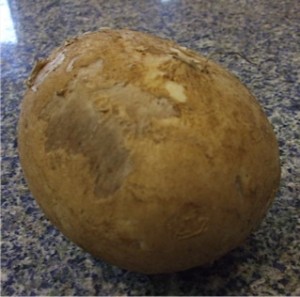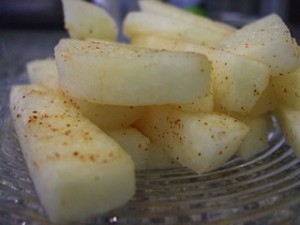 Jicama (pronounced HICK-ah-mah) is my new FAVORITE food. It doesn’t look like much in the produce section (and my picture doesn’t make it look any better) but boy is it a treat.
Jicama (pronounced HICK-ah-mah) is my new FAVORITE food. It doesn’t look like much in the produce section (and my picture doesn’t make it look any better) but boy is it a treat.
If you love fruit and are trying to watch your sugar intake you know it can be very difficult. I think Jicama can help. The flavor is a cross between an apple and a potato or cucumber. It’s mild but a bit sweet. I definitely taste the apple. It’s also full of water and crunchy, so good.
Jicama is neither a fruit nor a vegetable, it’s actually a legume. I know, all you paleo people are gasping and getting ready click over to a page that has information you can actually use. Well, not so fast. Here’s a quote from Melissa at Whole30 about why Jicama is an approved food.
The potential downsides of legumes are all found in the seed. The anti-nutrients, inflammatory compounds, phytoestrogens (in the case of soy) and carbohydrate density (in the case of many legumes) are all packed into the seed.
When you eat jicama, you’re eating the root, which has none of the same issues as the seed. (As an aside, you’d never, ever eat the seed of a jicama – it’s actually quite toxic.) This is the same logic by which it’s okay to eat bean sprouts (the grassy part that grows out of the seed), but not the beans themselves.
The above quote from Melissa at Whole30 actually came from another blog I like called TheClothesMakeTheGirl – also a huge fan of Jicama. Melissa (I know, confusing), the blogger at TheClothesMakeTheGirl also has a new cookbook with a couple of Jicama recipes: Jicama “Potato” Salad and Jicama Homefries. Yum.
So, back to my yummy Jicama snack/fruit replacement idea. After having Jicama at a friends house, I started to do a little research. Turns out Jicama is found all over South America and really popular in Mexican food. One thing I read was that you can buy Jicama from street vendors in Mexico. They soak the Jicama in lemon juice and then sprinkle it with chili pepper. Sounded good so that’s what I did.

After cutting the Jicama in half, the tough outer layer can mostly be peeled off with your fingers. Once you have most of that off you can finish peeling with a potato peeler. It looks like an apple or a pear once it’s peeled. I then cut the Jicama into sticks/spears put them in a container with freshly squeezed lemon juice (I used a half a lemon for half the Jicama). I left the Jicama sitting in the lemon juice until I was ready to eat it. I did sprinkle it with a little salt and then chili pepper. I was nervous about the chili pepper because it’s usually too hot for me. Not on the Jicama, I had to add more I could hardly taste it. Anyway, the final verdict – YUM!
I had the second half of the Jicama the next day for lunch. I squeezed the lemon juice on but didn’t let it sit. I was to excited to eat it. It was just as good. I didn’t notice a difference between letting it sit in lemon juice and just eating it instantly. Thank goodness because I don’t usually have the patience to wait something like that out.
Here is some more information about Jicama that I think you will like.
Nutritional Facts
1 cup sliced (120 grams) – Jicama can be big. One half of my Jicama was 290 grams, oops. (source)
- Calories 46 (apple has 53 calories)
- Fat 0
- Total Carbs 11 (apple has 14 carbs)
- Fiber 6 (apple has 1 gram)
- Sugar 2 (apple has 11 grams)
- Protein 1
- Glycemic Load 2 (awesome)
* info. about the apple is for 1 cup sliced (110 grams)
More good news, the soluble fiber found Jicama is inulin (IN-yew-linn).
Inulin has been the subject of intensive research in recent years, and the news adds important reasons to eat plenty of foods high in this fiber. Inulin promotes bone health by enhancing absorption of calcium from other foods, thus protecting against osteoporosis. It promotes heart health because soluble fiber decreases LDL cholesterol, and your heart will be healthier when you are an ideal weight. Inulin functions in the intestine as a prebiotic, meaning it is a food for the “good” bacteria that keep your colon healthy and balance your immunity. A study from British Journal of Nutrition in 2005 summarized very positive animal and human data on the role of inulin in preventing colon cancer. (source)
Jicama is a high fiber food so if you dive right in and eat a ton you may experience some digestive discomfort like bloating and gas. If you tend to eat a lot of fiber you will be fine but if you do experience some discomfort just eat small servings and build up slowly. I dove right in and ate the whole thing all by myself in two consecutive days and was fine. No digestive upset.
Here is some information about how to buy the best Jicama.
When choosing jicama at the store, look for medium sized, firm tubers with dry roots. Do not purchase jicama that has wet or soft spots, which may indicate rot, and don’t be drawn to overlarge examples of the tuber, because they may not be as flavorful. Jicama will keep under refrigeration for up to two weeks. (source)
So there you have it. Jicama. Go get some today, you’ll love it.
Eat Well, Feel Good, Have Fun!

I’m Amy a board certified holistic nutritionist, certified functional nutritionist and lifestyle practitioner and certified Life Coach. I help women in midlife understand the changing needs of their body so that they can stop dieting and lose weight permanently. At 56 I live what I teach. Don’t believe the story that your best years are behind you. They are not. Your best years are just starting!
